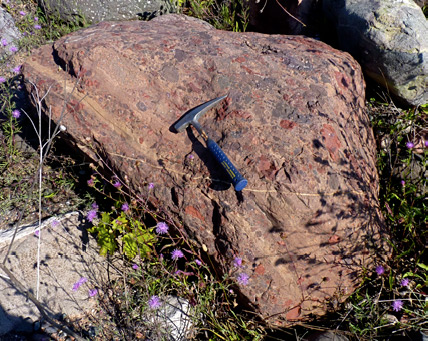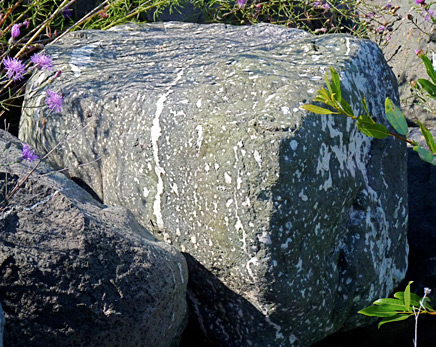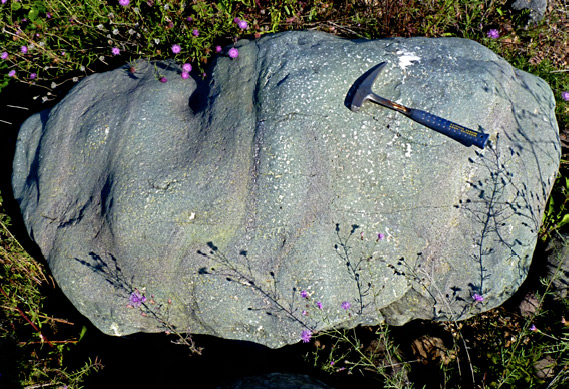Keweenaw Boulder Gallery
A geological art project of research and educational value for Michigan Tech
By Dr. Bill Rose
|

Bill Rose, Lynn Watson, landscape architect and Ashok Agarwal, Rock site designer with a large conglomerate boulder
|
Summary
For 40 years I have noticed that glacial boulders are abundant and beautiful in the copper country, but they are underutilized for their educational and artistic potential. I have looked constantly for excellent examples, finding an occasional gem, but never a collection that is together of great interest until now. |
 This summer, while working on the design of a field class in earth sciences, I entered the Mohawk Sand and Gravel quarry between Ahmeek and Copper City. There, as part of a much larger group of boulders harvested from glacial outwash, I found an extraordinary group of about 30-35 boulders which are naturally-shaped (glacially transported) examples of all the major rock types of the Peninsula, including dramatic examples of the important individual rock types that come from solidification of huge lava flows (Vesicular flow tops, fissures, pegmatites, ophitic portions), conglomerates, sandstones. We supplemented that collection with two excellent boulders that were already on campus, near the SDC. Each of the boulders is a museum specimen, but they are larger and more robust than those stored inside. They have been outside for decades and do not need shelter. The size of these rocks is mostly 1-2 m in diameter. They have been arranged artistically in a small plaza to allow for people to walk around them. They will be supplemented with educational materials which are being developed for research and teaching purposes. They can be used in geological and material science classes and would also be an attraction to visitors. The timing and conception of this project was was triggered by the MiTEP research project about earth science teaching, sponsored by the US National Science Foundation which emphasizes hands on teaching of field topics. This project very much speaks to that need, and it is expected to be a model for similar projects on other campuses.
This summer, while working on the design of a field class in earth sciences, I entered the Mohawk Sand and Gravel quarry between Ahmeek and Copper City. There, as part of a much larger group of boulders harvested from glacial outwash, I found an extraordinary group of about 30-35 boulders which are naturally-shaped (glacially transported) examples of all the major rock types of the Peninsula, including dramatic examples of the important individual rock types that come from solidification of huge lava flows (Vesicular flow tops, fissures, pegmatites, ophitic portions), conglomerates, sandstones. We supplemented that collection with two excellent boulders that were already on campus, near the SDC. Each of the boulders is a museum specimen, but they are larger and more robust than those stored inside. They have been outside for decades and do not need shelter. The size of these rocks is mostly 1-2 m in diameter. They have been arranged artistically in a small plaza to allow for people to walk around them. They will be supplemented with educational materials which are being developed for research and teaching purposes. They can be used in geological and material science classes and would also be an attraction to visitors. The timing and conception of this project was was triggered by the MiTEP research project about earth science teaching, sponsored by the US National Science Foundation which emphasizes hands on teaching of field topics. This project very much speaks to that need, and it is expected to be a model for similar projects on other campuses.
 Cost and creative help
Cost and creative help
The total cost of this project is currently about $8,000 (details are below if anyone cares). Ashok Agarwal a local contractor and rock artist and Geophysics graduate is the artistic and site preparation leader. Lynn Watson has provided design advice and leadership for landscaping—she has led such work for campus landscaping for the past few years. We also enjoyed support from Andy Niemi and others (especially Jerod Ledgerwood) from the MTU Grounds Management staff and critical advice from Bob Barron of GMES department on boulder groupings and general logistics. We also need to arrange for some materials for interpretation.
 Site
Site
The site selected is in the central campus where it can be used as envisioned for research and teaching purposes, but where it can also be appreciated for its historic and aesthetic value. We expect that it may take until next spring until the site is fully arranged, but we wanted to move the boulders only once, so it was advantageous to do that before winter. The site selection was done to avoid place that are used for other purposes (bicycle storage, snow statues, etc) with consultation with Campus Grounds management people. The campus itself is a glacial kame terrace, a feature formed 10,000 years ago when the continental glacier was covering Dollar Bay and the Keweenaw Peninsula north of the Portage Lake lift bridge, but it had receded from the part of the Keweenaw south of the bridge. Thus a 5000-10,000 foot high glacial front was located between the MTU campus and Dollar Bay, and the gravels of the Michigan Tech campus formed as water from glacial melts poured out to the south from the front of the receding glacier. At this place many boulders such as those now arranged in the garden were rounded and littered on the terrace. These boulders are found all over the Keweenaw, but have been removed from the surface to allow for buildings, lawns and parking lots. We have put them back in place, but we have also selected these boulders very carefully to follow an academic theme (see below).
 Research use of the Boulder Garden.
Research use of the Boulder Garden.
The use of the Boulder Garden is envisioned for geological laboratories in a number of classes where research about teaching is especially highlighted. The advantage of such a collection is that it groups in one place excellent examples of a broad variety of rocks that represent dozens of different places which can be examined all at once. In addition, the rocks are large enough that they contain much more information than small pieces of rocks. In one two hour class session students can observe and analyze data that could only be done from many days of field work, if they were to examine the same diversity of rocks.
 The theme is the Geology of the Keweenaw Rift, a geological event of ancient times (about 1.1 billion years ago) when the continent of those times (called Rodinia—it was long before there was any North America) began to split apart and when it was covered by huge lava flows. The rocks of the Keweenaw are mainly lavas (black rocks) and sediments (red rocks--sandstones and conglomerates), but there are many varieties represented and we have got most of them collected into one spot. So with one brief visit you can see great examples of all the local rocks. This allows a lot of interpretations of what the great rift and its environmental conditions were like. Thus the Boulder Garden becomes a place where full geological interpretation can be demonstrated to students in one class. We call this “reading the rocks” but without a boulder garden it cannot be done without using several field days, traveling from one rock outcrop to another. The garden will allow a holistic view of data from many field sites, to allow conception of a complex association of rocks at one time. In addition the glacial smoothing of rock surfaces makes them exceptionally favorable for seeing rock structure and texture. There are many rock features will allow the determination of the orientation of rocks in 3 dimensions (which way is up?). In the case of boulders the top direction is random, but the information about top and bottom remains and can be interpreted readily by students. Another particularly interesting issue that can be explored is the layering of flood basalt lava flows. The boulders represent different parts of the lava flows so students can be taught the structural elements of lavas and the variability of cooling and degassing which causes the textural differences. These features are also part of the training of materials scientists, and ceramicists.
The theme is the Geology of the Keweenaw Rift, a geological event of ancient times (about 1.1 billion years ago) when the continent of those times (called Rodinia—it was long before there was any North America) began to split apart and when it was covered by huge lava flows. The rocks of the Keweenaw are mainly lavas (black rocks) and sediments (red rocks--sandstones and conglomerates), but there are many varieties represented and we have got most of them collected into one spot. So with one brief visit you can see great examples of all the local rocks. This allows a lot of interpretations of what the great rift and its environmental conditions were like. Thus the Boulder Garden becomes a place where full geological interpretation can be demonstrated to students in one class. We call this “reading the rocks” but without a boulder garden it cannot be done without using several field days, traveling from one rock outcrop to another. The garden will allow a holistic view of data from many field sites, to allow conception of a complex association of rocks at one time. In addition the glacial smoothing of rock surfaces makes them exceptionally favorable for seeing rock structure and texture. There are many rock features will allow the determination of the orientation of rocks in 3 dimensions (which way is up?). In the case of boulders the top direction is random, but the information about top and bottom remains and can be interpreted readily by students. Another particularly interesting issue that can be explored is the layering of flood basalt lava flows. The boulders represent different parts of the lava flows so students can be taught the structural elements of lavas and the variability of cooling and degassing which causes the textural differences. These features are also part of the training of materials scientists, and ceramicists.
 Other uses of the Garden
Other uses of the Garden
The rock garden is expected to generate many spontaneous usages. Rocks are often used as art objects and the selected boulders have personalities and auras that are expected to generate ideas. We note that the site has already been used for poetry readings. Stone circles such as stonehenge are sites with spiritual and astronomical significance, and it is hoped that this may develop in this case. We have grouped the boulders in “families” which relate to their geological origin but we invite diverse interpretations of these natural objects.
Dedication of the Garden
I propose doing a formal dedication ceremony sometime soon, with a brief celebration of the garden, to attract shareholders of the project and to toast the idea. I am proud that Michigan Tech, including the president, the GMES department, the Seaman Museum and the Grounds staff have supported the idea enthusiastically. I think it’s appreciation will grow and it will be to our lasting credit.
Bill Rose
21 October 2010
Cost details (for those who care):
The cost of these boulders was $40/ton. And the aggregate purchase about $2100. Additional costs of the project include transport (about $1200) use of a fork lift for boulder placements ($320), a contract with an artist for site preparation and aesthetic arrangement ($3000), and landscaping costs for the areas around the boulders (~$1500). Most of the costs are being paid for from research incentive funds that had accumulated in my name over the past couple of years, while doing research on teaching of earth science. I am prepared to donate an additional $2K to MTU to support additional costs if needed.

